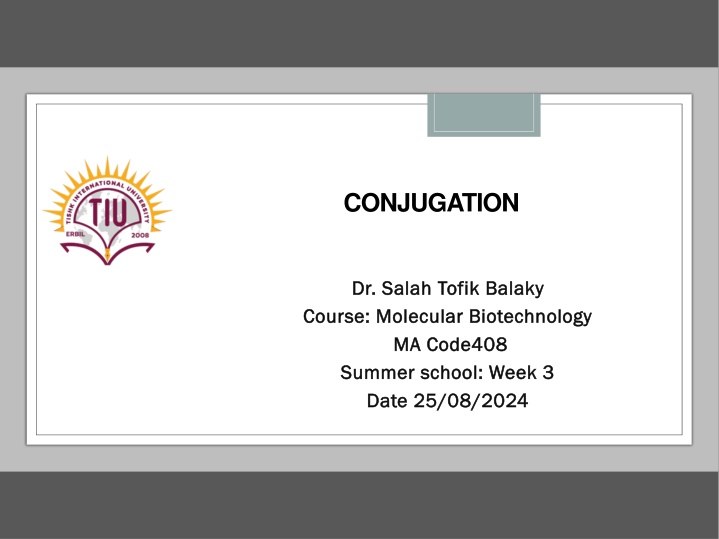Bacterial Conjugation and Its Significance in Antibiotic Resistance
Bacterial conjugation enables the transfer of genetic material between cells, impacting antibiotic resistance spread. F-type and P-type conjugation mechanisms play vital roles in bacterial evolution and resistance gene transmission. Understanding these processes is crucial for combating antibiotic resistance.
Download Presentation

Please find below an Image/Link to download the presentation.
The content on the website is provided AS IS for your information and personal use only. It may not be sold, licensed, or shared on other websites without obtaining consent from the author.If you encounter any issues during the download, it is possible that the publisher has removed the file from their server.
You are allowed to download the files provided on this website for personal or commercial use, subject to the condition that they are used lawfully. All files are the property of their respective owners.
The content on the website is provided AS IS for your information and personal use only. It may not be sold, licensed, or shared on other websites without obtaining consent from the author.
E N D
Presentation Transcript
CONJUGATION Dr. Salah Dr. Salah Tofik Course: Molecular Biotechnology Course: Molecular Biotechnology MA Code408 MA Code408 Summer school: Week 3 Summer school: Week 3 Date 25/08/2024 Date 25/08/2024 Tofik Balaky Balaky
Conjugation Conjugation requires contact between living cells of opposite mating types. The donor cell, called an F+ cell (corresponding to maleness), has extra DNA pieces called F (or fertility) factors. These are a type of plasmid, a free genetic element in the cell. When F+ and F (corresponding to femaleness) cells are mixed, the F+ cells attach by sex pili to F cells. 2
Conjugation main characteristics 1.Conjugation process requires cell-to-cell contact and mediated by fertility plasmids. 2. The fertile cell forms a sex pilus to connect the recipient and the plasmid DNA replicate. 3. Genes from Donor cells F+ move into F-. 4. Fertility plasmid will be transferred from the donor cell to the recipient cell, both cells will separate. 3
Different types of bacterial conjugation 1. F-type conjugation. 2. P-type conjugation. 3. Type IV secretion systems (T4SSs). 4
F-type conjugation This type of conjugation is mediated by the F plasmid and is the most well-studied. It involves the transfer of genetic material from the donor bacterium to the recipient bacterium through the formation of a conjugative pilus. 5
P-type conjugation This type of conjugation is mediated by the P plasmid and is less well-studied compared to F-type conjugation. It also involves the transfer of genetic material from the donor bacterium to the recipient bacterium through the formation of a conjugative pilus. The P plasmid is also a self-replicating plasmid that can carry antibiotic resistance genes and other traits beneficial to the recipient bacterium. 7
Significance of conjugation Each of these types of bacterial conjugation plays a significant role in the spread of antibiotic resistance genes and the evolution of bacterial populations. Understanding the mechanisms and regulation of these processes is essential for the development of effective strategies to combat the spread of antibiotic resistance and to prevent the emergence of new bacterial pathogens. 8























